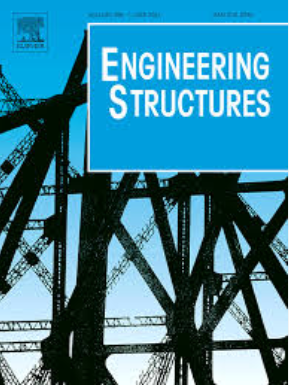Structural assessment of rehabilitated culverts under momentary loads using vision-based measurements and model calibration
IF 5.6
1区 工程技术
Q1 ENGINEERING, CIVIL
引用次数: 0
Abstract
This study leverages visualization techniques and model updating to evaluate previously unknown in-situ conditions, both before and after rehabilitation using a cementitious spray-applied pipe liner (SAPL) on a culvert. Full-scale field load tests are conducting using non-contact, vision-based measurements to accurately quantify deformations due to static and dynamic loads for the two conditions: 1) unlined (before rehabilitation) and 2) lined (after rehabilitation) to characterize the in-situ structural response of the culvert before and after the SAPL application. Using digital image correlation (DIC) techniques, field measurements captured deformations along the culvert and were used to calibrate a finite element (FE) model to account for the existing state of material properties and soil conditions, often unknown when evaluating existing structures. The vision-based approach coupled with model updating enables the visualization and calibration of multiple points, minimizing unintended consequences of assumptions in modeling structures. Field tests and calibrated FE analyses confirmed that the lined culvert exhibited increased ring stiffness, improved resistance to dynamic load effects, and enhanced structural integrity. These improvements resulted in reduced deflections, beam-on-elastic-foundation behavior with dampened responses to varying load magnitudes, and more uniform strain distribution under both static and dynamic loads. The integration of DIC with model updating establishes a robust methodology for evaluating structures and refining numerical models. This study highlights the importance of combining advanced DIC techniques and FE modeling to better understand in-situ behavior, especially at full-scale, that can inform rehabilitation strategies, especially for deteriorated infrastructure
基于视觉测量和模型校正的瞬时荷载下修复涵洞结构评估
本研究利用可视化技术和模型更新来评估以前未知的原位条件,包括在涵洞上使用水泥喷涂管道内衬(SAPL)修复之前和之后。目前正在进行全尺寸现场荷载测试,使用非接触式、基于视觉的测量,以准确量化两种情况下由静态和动态载荷引起的变形:1)未衬砌(修复前)和2)衬砌(修复后),以表征SAPL应用前后涵洞的原位结构响应。利用数字图像相关(DIC)技术,现场测量捕获了涵洞沿线的变形,并用于校准有限元(FE)模型,以考虑材料属性和土壤条件的现有状态,这些在评估现有结构时通常是未知的。基于视觉的方法与模型更新相结合,可以实现多点的可视化和校准,最大限度地减少建模结构中假设的意外后果。现场测试和校准的有限元分析证实,衬砌涵洞的环刚度增加,抗动载荷效应增强,结构完整性增强。这些改进减少了挠度,减少了梁在弹性基础上对不同荷载量级的响应,并且在静态和动态荷载下的应变分布更加均匀。DIC与模型更新的整合为评估结构和改进数值模型建立了一种可靠的方法。该研究强调了将先进的DIC技术与有限元建模相结合的重要性,以更好地了解原位行为,特别是在全尺寸范围内,可以为修复策略提供信息,特别是对于恶化的基础设施
本文章由计算机程序翻译,如有差异,请以英文原文为准。
求助全文
约1分钟内获得全文
求助全文
来源期刊

Engineering Structures
工程技术-工程:土木
CiteScore
10.20
自引率
14.50%
发文量
1385
审稿时长
67 days
期刊介绍:
Engineering Structures provides a forum for a broad blend of scientific and technical papers to reflect the evolving needs of the structural engineering and structural mechanics communities. Particularly welcome are contributions dealing with applications of structural engineering and mechanics principles in all areas of technology. The journal aspires to a broad and integrated coverage of the effects of dynamic loadings and of the modelling techniques whereby the structural response to these loadings may be computed.
The scope of Engineering Structures encompasses, but is not restricted to, the following areas: infrastructure engineering; earthquake engineering; structure-fluid-soil interaction; wind engineering; fire engineering; blast engineering; structural reliability/stability; life assessment/integrity; structural health monitoring; multi-hazard engineering; structural dynamics; optimization; expert systems; experimental modelling; performance-based design; multiscale analysis; value engineering.
Topics of interest include: tall buildings; innovative structures; environmentally responsive structures; bridges; stadiums; commercial and public buildings; transmission towers; television and telecommunication masts; foldable structures; cooling towers; plates and shells; suspension structures; protective structures; smart structures; nuclear reactors; dams; pressure vessels; pipelines; tunnels.
Engineering Structures also publishes review articles, short communications and discussions, book reviews, and a diary on international events related to any aspect of structural engineering.
 求助内容:
求助内容: 应助结果提醒方式:
应助结果提醒方式:


